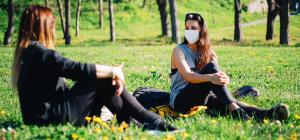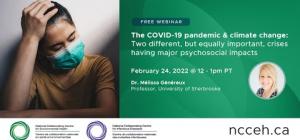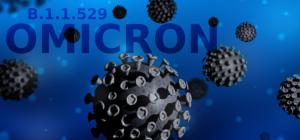
Masking and unmasking during the COVID-19 pandemic and beyond

More than a year and a half since COVID-19 became part of our vocabulary, we are still talking about masks, which have now become a fixture of daily life. Concern over changing language and understanding of the main modes of transmission, and risks of exposure via inhalation of aerosols have led some to purport that only the wearing of an N95 respirator will prevent transmission of SARS-CoV-2. But is recommending use of respirators on a community scale practical and is it likely to be effective? What does the literature say about the comparative efficacy of different mask types, new materials such as nano-materials, and mask modifications? Are there measures that can be taken to improve the effectiveness of cloth or surgical masks? And looking ahead to a post-pandemic world, and potentially living alongside endemic COVID or other respiratory illnesses, how does mask-wearing fit in? These are some of the key issues addressed in our recent update on Masking during the COVID-19 pandemic and summarized in this companion blog.
What is new about masking?
Our initial review of evidence on masking for reducing transmission of respiratory illnesses (April 2020) covered much of the early literature, which was based on influenza or influenza-like respiratory illness and healthcare settings for the protection of healthcare workers. The COVID-19 pandemic has driven a substantial increase in masking research, particularly new experimental, observational, and modelling studies, which we covered in subsequent updates to our review in October 2020 and more recently in May 2021. The benefits of masking have been reported in observational studies in various settings (e.g., factories, among close contacts, community settings), and modelling studies, as covered in our update, have reported an association between mask use in the community and reduction in COVID-19 cases and deaths. We now also know more about the physical properties of masks and the importance of materials and fit for ensuring good filtration efficiency. The literature clearly shows that the effectiveness of masks for reducing transmission of respiratory viruses is influenced both by the type of mask worn and how it is worn, with fit and adherence to mask-use influencing performance.
What is new on mask materials?
We have seen an explosion in the number of experimental studies measuring filtration efficiency (FE) of hundreds of different household materials and combinations of materials. A wide range of performance is reported for cloth masks, with FE being as low as < 5%, to as high as > 90%, depending on the type of material and layers. Most non-medical face coverings block large particles well, but good quality cloth masks can also block some aerosols. The best cloth masks are made of tightly woven materials, with multiple layers that maintain a good level of comfort and breathability and can compete with some surgical masks for FE, although cannot typically achieve the FE of certified respirators such as N95s.
New materials have been proposed by manufacturers to increase the functionality of masks by improving particle removal, breathability, electrostatic action, or adding an antimicrobial element in the form of nanoparticles. There remains limited published evidence on the efficacy and safety of nanomaterials used in masks, with concerns over dermal exposure or inhalation of nanoparticles. Health Canada issued an advisory and subsequent recall for masks containing the nanomaterial graphene or biomass graphene, based on possible inhalation risks. Research is ongoing to investigate exposure risks from nanoparticles (e.g., nano silver, titanium dioxide) in masks by Sciensano (Belgian Institute for Health) in the AgMask project. Further research is ongoing to identify inhalation risks in topic areas such microplastic inhalation.
Mask fit remains important
The expanding literature on masks has emphasized the importance of good fit to good performance. A high-quality mask can only filter particles in air that passes through it. Air that finds a path of lower resistance through gaps and leaks can reach the breathing zone unfiltered. While performance of a fit-tested, certified, N95 respirator (or equivalent) provides the highest level of protection, measured under controlled conditions, there are many factors that can reduce performance in a real-world setting. In controlled settings, healthcare workers are fit-tested to ensure respirators are suitable for specific face shapes and sizes. They are also trained in performing user-seal checks every time they put on a respirator. In a community setting, members of the public are unlikely to be fit-tested prior to selecting a respirator. People with small faces or facial hair may have difficulty in finding a respirator that can achieve a good fit, and people with full beards may not find any respirator that will pass a fit-test. The public is unlikely to have easy access to fit-testing services or be trained in performing user-seal checks. Even among trained professionals, user-seal checks may fail to detect leaks, which can result in a significant reduction in performance.
Mask fit has become the focus of emerging research on modifications or double masking to improve FE. Brooks et al. demonstrated that a double mask made of a 3-ply cloth mask over a 3-ply procedure mask blocked 85.4% of aerosols compared to 51.4% and 56.1% with a single cloth or procedure mask, respectively. When both the source and the exposed subject used a double mask, exposure was reduced by 94.5% overall. Guidance on double masking is now provided by the US CDC, suggesting the use of a procedure mask beneath a cloth mask to maximise benefit. Other modifications such as mask fasteners, fitters or braces that improve the fit of a mask around the face have been found to significantly reduce leakage and improve FE. Modified procedure masks and surgical masks have been observed to achieve > 80% FE in some tests, with a greater reduction in exposure overall when both the source and exposed subjects wore a modified mask.
Adhering to good mask-wearing behaviours
Observation of poor mask-wearing behaviours such as wearing a mask under the nose or chin, lowering the mask to talk, cough or sneeze, or failing to perform hand hygiene before donning or doffing a mask have become common place. Poor adherence to mask-wearing could reduce the source control and protective effect provided by masks. The comfort of a mask can also have a big impact on whether protective effect can be maintained. Discomfort can lead to frequent adjustments of masks and is a primary reason for non-adherence to mask use or poor mask-wearing behaviours. Cotton and procedure/surgical masks often perform better than respirators for comfort, and hence can encourage greater adherence, especially for continuous use.
Recommending community-wide use of N95s or equivalent raises practical concerns about whether a 95% FE can reasonably be achieved among the public, given the likelihood of poor adherence, in addition to fit issues mentioned earlier. An evaluation of the real-world level of protection provided by N95 use in the public should be compared to the level of protection provided by a good quality, well-fitted, surgical, or non-medical mask, complemented by other measures such as awareness-raising about good mask fit, good mask-wearing behaviours, and recognizing high-risk situations where mask-wearing is more beneficial (e.g., indoor, crowded, poorly ventilated spaces).
Is mask-wearing here to stay?
As vaccination rates increase around the world, we are seeing a move towards relaxation of non-pharmaceutical interventions (NPIs) such as travel restrictions, distancing, school closures and mask-wearing. While relaxation of NPIs is welcomed by many, there is still some hesitance to remove masks too soon. The US CDC indicated in early May 2021 that mask-wearing requirements would be relaxed for fully vaccinated people in any setting, outdoors or indoors, except where required by other federal, state, local, tribal or territorial laws, rules and regulations. This includes maintaining mask-wearing on planes and public transportation, with the scientific basis for this linked to the observed effectiveness of vaccines for reducing symptomatic illness and asymptomatic infection or transmission. The lifting of masking requirements so far has been gradual, starting with outdoor public spaces, where they apply, and gradually moving to more locations.
A remaining area of concern is the potential for new variants of concern (VOC) to emerge while a large segment of the population remains unvaccinated. A report by the UK SAGE group in reference to mask use and VOC reported that the mode of transmission for SARS-CoV-2 has not changed, but the increased transmissibility of VOC likely means that a lower dose and shorter exposure may lead to transmission. The efficacy of current vaccines against future VOC remains unknown, implying that a gradual approach to lifting masking recommendations is needed. Modelling has indicated that there remains a risk of infection even to vaccinated people while community transmission of the virus remains high. Modelling by Patel et al. found that removing NPIs before there was widespread coverage of vaccination (e.g., > 75%) could result in substantial increases in infection, hospitalizations, and deaths. Another model by Moore et al. using epidemiological data from the UK found that vaccination alone is insufficient to contain the spread of the virus, and NPIs should be maintained during vaccination rollout.
Looking ahead to a post-pandemic world, and potentially living alongside endemic COVID or other respiratory illnesses, what does the future of mask-wearing look like? We have seen a benefit of public health measures for reducing rates of respiratory illnesses, including a decline in reported cases of flu and other respiratory illnesses in the past winter flu season. This was likely due to the combined effects of multiple NPIs, although mask-wearing could have played an important role. Many individuals may choose to continue wearing masks when in crowded public spaces, when meeting with large groups, on public transit or during winter flu season. This choice may depend on factors such as comfort, impact on communication with others, or perception of risks in some settings (e.g., public transit, healthcare, long-term care facilities). While masks remain a part of daily life, the public should be reminded of the benefits of using good quality masks, ensuring a good fit, and observing good mask-wearing behaviours.
See also: Masking during the COVID-19 pandemic – An update of the evidence







